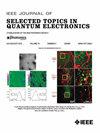增强光子自旋霍尔效应的压电等离子体系统在光学折射率传感中的应用
IF 5.1
2区 工程技术
Q1 ENGINEERING, ELECTRICAL & ELECTRONIC
IEEE Journal of Selected Topics in Quantum Electronics
Pub Date : 2025-04-01
DOI:10.1109/JSTQE.2025.3556890
引用次数: 0
摘要
等离子体和压电表面之间强烈的自旋轨道相互作用(SOIs)为精确控制极化状态和波前整形提供了一种有前途的解决方案。由可变电压和SOIs驱动的可重构光束操纵已成为先进光学系统的关键焦点。尽管具有这种潜力,但压电材料的机械刚性及其固有的静态光学特性在制造后提出了重大挑战,限制了它们的适应性和动态功能。本研究探索了等离子体和压电材料的集成,以克服这些限制,使可调谐SOIs的折射率和厚度的电压控制调制成为可能。在本文中,由光的SOI引起的光子自旋霍尔效应(PSHE)在由银(Ag),压电材料PMN-PT和附加Ag层组成的层状结构中得到了证明。通过施加-5.874 V的电压偏置(VB),左圆极化在PMN-PT层厚度为387nm时实现了143.357 μm的最大常规自旋相关位移(CSDS),优于先前报道的PSHE研究。此外,由于PMN-PT的特殊可调性,所提出的PSHE框架显示出抗原或互补DNA检测的潜力。在-5.874 V电压偏置下,折射率变化Δn = 1 × 10-3时,获得了610430.50 μm/RIU的自旋依赖灵敏度。此外,所提出的传感器设计(str-3)的检测极限(${\bm{Lo}}{{\bm{D}}}_{{\bm{sd}}}}$)为1.638 × 10-9度。RIU/μm,标志着精密光学传感的重大进步。本文章由计算机程序翻译,如有差异,请以英文原文为准。
Piezoplasmonic System for Enhanced Photonic Spin Hall Effect for Applications in Optical Refractive Index Sensing
The interplay of intense spin-orbit interactions (SOIs) with plasmonic and piezoelectric surfaces offers a promising solution for precise control over polarization states and wavefront shaping. Reconfigurable beam manipulation, driven by variable voltage and SOIs, has emerged as a key focus in advancing optical systems. Despite this potential, the mechanical rigidity of piezoelectric materials and their inherently static optical properties post-fabrication present significant challenges, restricting their adaptability and dynamic functionality. This study explores the integration of plasmonic and piezoelectric materials to overcome these limitations, enabling voltage-controlled modulation of refractive index and thickness for tunable SOIs. In this manuscript, the photonic spin Hall effect (PSHE), arising from the SOI of light, is demonstrated in a layered structure consisting of silver (Ag), the piezoelectric material PMN-PT, and an additional Ag layer. By applying a voltage bias (VB) of –5.874 V, left-hand circular polarization achieves a maximum conventional spin dependent shift (CSDS) of 143.357 μm for a PMN-PT layer thickness of 387 nm, outperforming previously reported PSHE studies. Further, the proposed PSHE framework demonstrates potential for antigen or complementary DNA detection, owing to the exceptional tunability of PMN-PT. A spin-dependent sensitivity of 610430.50 μm/RIU is achieved at a refractive index change of Δn = 1 × 10-3 under a voltage bias of –5.874 V for complementary DNA sensing. Furthermore, the proposed sensor design (str-3) exhibits an extraordinary limit of detection (${\bm{Lo}}{{{\bm{D}}}_{{\bm{sd}}}}$
求助全文
通过发布文献求助,成功后即可免费获取论文全文。
去求助
来源期刊

IEEE Journal of Selected Topics in Quantum Electronics
工程技术-工程:电子与电气
CiteScore
10.60
自引率
2.00%
发文量
212
审稿时长
3 months
期刊介绍:
Papers published in the IEEE Journal of Selected Topics in Quantum Electronics fall within the broad field of science and technology of quantum electronics of a device, subsystem, or system-oriented nature. Each issue is devoted to a specific topic within this broad spectrum. Announcements of the topical areas planned for future issues, along with deadlines for receipt of manuscripts, are published in this Journal and in the IEEE Journal of Quantum Electronics. Generally, the scope of manuscripts appropriate to this Journal is the same as that for the IEEE Journal of Quantum Electronics. Manuscripts are published that report original theoretical and/or experimental research results that advance the scientific and technological base of quantum electronics devices, systems, or applications. The Journal is dedicated toward publishing research results that advance the state of the art or add to the understanding of the generation, amplification, modulation, detection, waveguiding, or propagation characteristics of coherent electromagnetic radiation having sub-millimeter and shorter wavelengths. In order to be suitable for publication in this Journal, the content of manuscripts concerned with subject-related research must have a potential impact on advancing the technological base of quantum electronic devices, systems, and/or applications. Potential authors of subject-related research have the responsibility of pointing out this potential impact. System-oriented manuscripts must be concerned with systems that perform a function previously unavailable or that outperform previously established systems that did not use quantum electronic components or concepts. Tutorial and review papers are by invitation only.
 求助内容:
求助内容: 应助结果提醒方式:
应助结果提醒方式:


